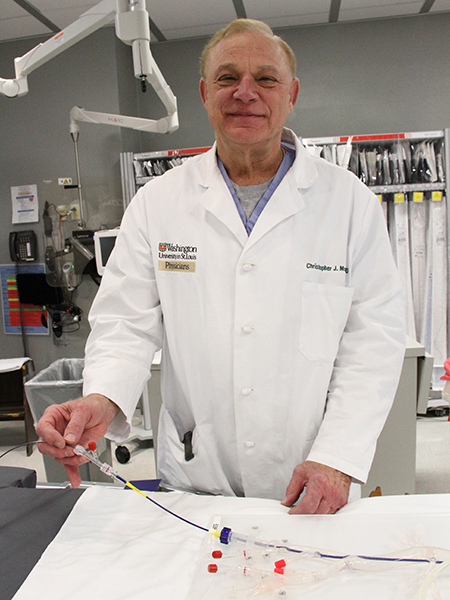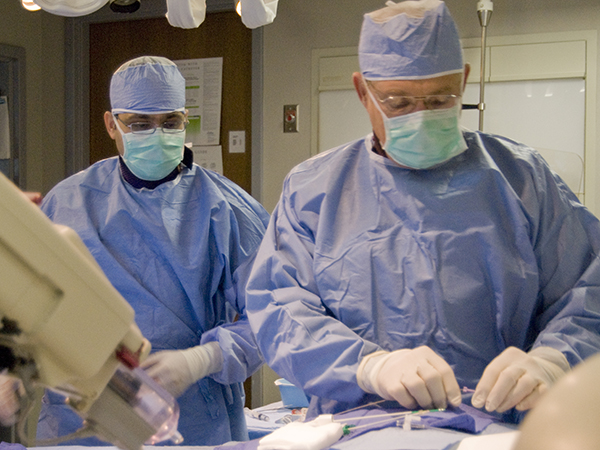In 1978, after completing his residency and a neuroradiology fellowship at Mallinckrodt Institute of Radiology (MIR), Christopher J. Moran, MD, decided to stay and become a faculty member because he saw MIR as he saw himself: an enthusiastic early adopter of promising new technologies and techniques.
During his 45-year career, Moran has helped keep MIR on the cutting edge. He has published more than 175 peer-reviewed papers, earned seven patents, and developed a national reputation as a respected innovator and instructor of lifesaving neuroradiological interventions.
Seizing New Technological Opportunities

When Moran first joined faculty, MIR was a leader in head CTs and angiography, and home to one of the first six CT scanners in the U.S. Five years later, he earned two patents: one for cranial insertion of surgical needles using CTs, and another for creating a surgical guidance apparatus for use with a CT scanner. He honed his skills under the mentorship of Mokhtar Gado, MD, and Thomas Naidich, MD, whom he considers giants in neuroradiology.
“The leadership always let us innovate,” he says. “And I like getting those things in my hand to test if they’re as good, better or worse than someone else has claimed.”
In the late 1980s and early 1990s, Moran published several papers and earned two more patents for devices for conductive interstitial hyperthermia, which elevates the temperature of tumor tissue to damage and destroy cancer cells. In 1991, he was joined in the department by DeWitte Cross III, MD, who was there to establish an interventional neuroradiology (INR) service at MIR. Moran and Cross worked side-by-side until the latter’s retirement in 2019. Together they helped develop a robust service that now has a faculty of five and, according to Moran, performs more neurointerventional radiology procedures than any other provider in St. Louis and the surrounding areas.
“Dr. Moran always had the enthusiasm of a teenager with the experience of a master,” says Cross. “He was very focused on using the latest techniques, being up to date and doing everything he could for the patient.”
A Respected Pioneer in Flow Diverters
Moran is especially known for his mastery of flow diverters for intercranial aneurysms. He was part of the landmark PUFS (Pipeline for Uncoilable or Failed Aneurysms) study, published in 2013 in Radiology, which proved the safety and efficacy of the pipeline embolization device (PED). “Previously, a lot of these aneurysms were impossible to treat. Now we had a means of treating them,” he says. “The complications were lower and the occlusion rate was higher. Which is spectacular.”

He quickly became the go-to expert on the device. He has since traveled to more than 200 medical facilities across the country to serve as a procedure trainer and proctor and has delivered countless lectures on the device.
In 2020, he was named a fellow of the Society of NeuroInterventional Surgery, the most prestigious honor granted to members in recognition of professional achievement in the field. And for the past 25 years, he has served as a scientific advisor for grants issued by the Radiological Society of North America research and education fund. “These grants primarily go to the young radiologists we’re training,” Moran says. “They’re the future of the field.”
Dedicated to Quality Improvement and Communication
Moran says that the innovative advances for which he is known can only be successful if patients can be admitted and treated in time. To that end, he has devoted time and effort to quality improvement, serving for a decade as chairman of MIR’s Continuous Quality Improvement Committee.

He is particularly proud of a successful campaign to greatly reduce “door to needle” time, the time that elapses from when a patient arrives to when an intervention is started. In 2017, those standardization efforts won the Team Award for Quality for Barnes-Jewish Hospital’s Endovascular Acute Stroke Committee.
Quality improvement rests, in part, on good communication between colleagues within and beyond your own service, Moran says. Since 2003, he has held a dual appointment as a professor of neurological surgery at the School of Medicine.
“He saw that it was critical and important to build relationships with other services,” Cross says. “He has always been very good at talking with other specialists about the best approach for a patient and then following up and keeping tabs on the patient afterward.”
Four Decades of Growth and Dedication
MIR has grown and advanced tremendously over the four-plus decades that Moran has been on faculty. As technology has leapfrogged, he has been there for every hop forward. And as the numbers of residents and fellows have nearly tripled since his class, he has been happy to pass down his institutional knowledge to them.
“I particularly enjoy working one-on-one with residents who are extremely thirsty for knowledge,” he says. “I love slaking that thirst and sharing with them all that I learned from those who came before me at MIR.”
Published in Focal Spot Spring/Summer 2023 Issue

